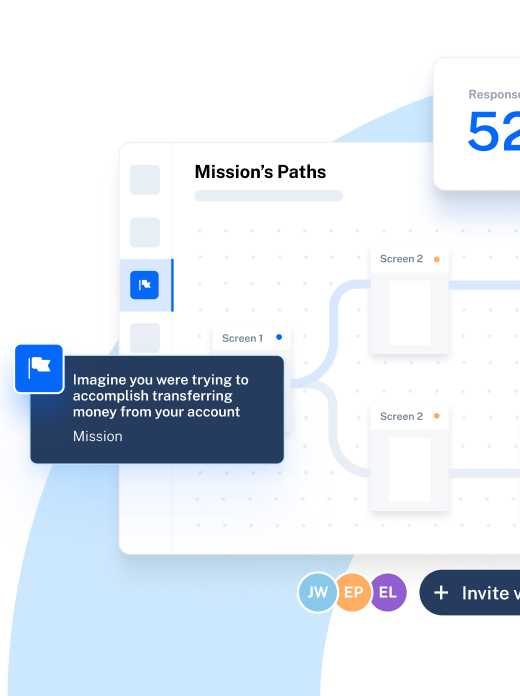All great products were once just thoughts—the spark of an idea waiting to be turned into something tangible.
A research hypothesis in UX is very similar. It’s the starting point for your user research; the jumping off point for your product development initiatives.
Formulating a UX research hypothesis helps guide your UX research project in the right direction, collect insights, and evaluate not only whether an idea is worth pursuing, but how to go after it.
In this article, we’ll cover what a research hypothesis is, how it's relevant to UX research, and the best formula to create your own hypothesis and put it to the test.
What defines a research hypothesis?
A research hypothesis is a statement or prediction that needs testing to be proven or disproven.
Let’s say you’ve got an inkling that making a change to a feature icon will increase the number of users that engage with it—with some minor adjustments, this theory becomes a research hypothesis: “Adjusting Feature X’s icon will increase daily average users by 20%”.
A research hypothesis is the starting point that guides user research. It takes your thought and turns it into something you can quantify and evaluate. In this case, you could conduct usability tests and user surveys, and run A/B tests to see if you’re right—or, just as importantly, wrong.
A good research hypothesis has three main features:
- Specificity: A hypothesis should clearly define what variables you’re studying and what you expect an outcome to be, without ambiguity in its wording
- Relevance: A research hypothesis should have significance for your research project by addressing a potential opportunity for improvement
- Testability: Your research hypothesis must be able to be tested in some way such as empirical observation or data collection
What is the difference between a research hypothesis and a research question?
Research questions and research hypotheses are often treated as one and the same, but they’re not quite identical.
A research hypothesis acts as a prediction or educated guess of outcomes, while a research question poses a query on the subject you’re investigating. Put simply, a research hypothesis is a statement, whereas a research question is (you guessed it) a question.
For example, here’s a research hypothesis: “Implementing a navigation bar on our dashboard will improve customer satisfaction scores by 10%.”
This statement acts as a testable prediction. It doesn’t pose a question, it’s a prediction. Here’s what the same hypothesis would look like as a research question: “Will integrating a navigation bar on our dashboard improve customer satisfaction scores?”
The distinction is minor, and both are focused on uncovering the truth behind the topic, but they’re not quite the same.
Why do you use a research hypothesis in UX?
Research hypotheses in UX are used to establish the direction of a particular study, research project, or test. Formulating a hypothesis and testing it ensures the UX research you conduct is methodical, focused, and actionable. It aids every phase of your research process, acting as a north star that guides your efforts toward successful product development.
Typically, UX researchers will formulate a testable hypothesis to help them fulfill a broader objective, such as improving customer experience or product usability. They’ll then conduct user research to gain insights into their prediction and confirm or reject the hypothesis.
A proven or disproven hypothesis will tell if your prediction is right, and whether you should move forward with your proposed design—or if it's back to the drawing board.
Formulating a hypothesis can be helpful in anything from prototype testing to idea validation, and design iteration. Put simply, it’s one of the first steps in conducting user research.
Whether you’re in the initial stages of product discovery for a new product, a single feature, or conducting ongoing research, a strong hypothesis presents a clear purpose and angle for your research It also helps understand which user research methodology to use to get your answers.
What are the types of research hypotheses?
Not all hypotheses are built the same—there are different types with different objectives. Understanding the different types enables you to formulate a research hypothesis that outlines the angle you need to take to prove or disprove your predictions.
Here are some of the different types of hypotheses to keep in mind.
Null and alternative hypotheses
While a normal research hypothesis predicts that a specific outcome will occur based upon a certain change of variables, a null hypothesis predicts that no difference will occur when you introduce a new condition.
By that reasoning, a null hypothesis would be:
- Adding a new CTA button to the top of our homepage will make no difference in conversions
Null hypotheses are useful because they help outline what your test or research study is trying to disprove, rather than prove, through a research hypothesis.
An alternative hypothesis states the exact opposite of a null hypothesis. It proposes that a certain change will occur when you introduce a new condition or variable. For example:
- Adding a CTA button to the top of our homepage will cause a difference in conversion rates
Simple hypotheses and complex hypotheses
A simple hypothesis is a prediction that includes only two variables in a cause-and-effect sequence, with one variable dependent on the other. It predicts that you'll achieve a particular outcome based on a certain condition. The outcome is known as the dependent variable and the change causing it is the independent variable.
For example, this is a simple hypothesis:
- Including the search function on our mobile app will increase user retention
The expected outcome of increasing user retention is based on the condition of including a new search function. But, what happens when there are more than two factors at play?
We get what’s called a complex hypothesis. Instead of a simple condition and outcome, complex hypotheses include multiple results. This makes them a perfect research hypothesis type for framing complex studies or tracking multiple KPIs based on a single action.
Building upon our previous example, a complex research hypothesis could be:
- Including the search function on our mobile app will increase user retention and boost conversions
Directional and non-directional hypotheses
Research hypotheses can also differ in the specificity of outcomes. Put simply, any hypothesis that has a specific outcome or direction based on the relationship of its variables is a directional hypothesis. That means that our previous example of a simple hypothesis is also a directional hypothesis.
- Including the search function on our mobile app will increase user retention
Non-directional hypotheses don’t specify the outcome or difference the variables will see. They just state that a difference exists. Following our example above, here’s what a non-directional hypothesis would look like:
- Including the search function on our mobile app will make a difference in user retention
In this non-directional hypothesis, the direction of difference (increase/decrease) hasn’t been specified, we’ve just noted that there will be a difference.
The type of hypothesis you write helps guide your research—let’s get into it.
How to write and test your UX research hypothesis
Now we’ve covered the types of research hypothesis examples, it’s time to get practical.
Creating your research hypothesis is the first step in conducting successful user research.
Here are the four steps for writing and testing a UX research hypothesis to help you make informed, data-backed decisions for product design and development.
1. Formulate your hypothesis
Start by writing out your hypothesis in a way that’s specific and relevant to a distinct aspect of your user or product experience. Meaning: your prediction should include a design choice followed by the outcome you’d expect—this is what you’re looking to validate or reject.
Your proposed research hypothesis should also be testable through user research data analysis. There’s little point in a hypothesis you can’t test!
Let’s say your focus is your product’s user interface—and how you can improve it to better meet customer needs. A research hypothesis in this instance might be:
- Adding a settings tab to the navigation bar will improve usability
By writing out a research hypothesis in this way, you’re able to conduct relevant user research to prove or disprove your hypothesis. You can then use the results of your research—and the validation or rejection of your hypothesis—to decide whether or not you need to make changes to your product’s interface.
2. Identify variables and choose your research method
Once you’ve got your hypothesis, you need to map out how exactly you’ll test it. Consider what variables relate to your hypothesis. In our case, the main variable of our outcome is adding a settings tab to the navigation bar.
Once you’ve defined the relevant variables, you’re in a better position to decide on the best UX research method for the job. If you’re after metrics that signal improvement, you’ll want to select a method yielding quantifiable results—like usability testing. If your outcome is geared toward what users feel, then research methods for qualitative user insights, like user interviews, are the way to go.
3. Carry out your study
It’s go time. Now you’ve got your hypothesis, identified the relevant variables, and outlined your method for testing them, you’re ready to run your study. This step involves recruiting participants for your study and reaching out to them through relevant channels like email, live website testing, or social media.
Given our hypothesis, our best bet is to conduct A/B and usability tests with a prototype that includes the additional UI elements, then compare the usability metrics to see whether users find navigation easier with or without the settings button.
We can also follow up with UX surveys to get qualitative insights and ask users how they found the task, what they preferred about each design, and to see what additional customer insights we uncover.
💡 Want more insights from your usability tests? Maze Clips enables you to gather real-time recordings and reactions of users participating in usability tests.
4. Analyze your results and compare them to your hypothesis
By this point, you’ve neatly outlined a hypothesis, chosen a research method, and carried out your study. It’s now time to analyze your findings and evaluate whether they support or reject your hypothesis.
Look at the data you’ve collected and what it means. Given that we conducted usability testing, we’ll want to look to some key usability metrics for an indication of whether the additional settings button improves usability.
For example, with the usability task of ‘In account settings, find your profile and change your username’, we can conduct task analysis to compare the times spent on task and misclick rates of the new design, with those same metrics from the old design.
If you also conduct follow-up surveys or interviews, you can ask users directly about their experience and analyze their answers to gather additional qualitative data. Maze AI can handle the analysis automatically, but you can also manually read through responses to get an idea of what users think about the change.
By comparing the findings to your research hypothesis, you can identify whether your research accepts or rejects your hypothesis. If the majority of users struggle with finding the settings page within usability tests, but had a higher success rate with your new prototype, you’ve proved the hypothesis.
However, it's also crucial to acknowledge if the findings refute your hypothesis rather than prove it as true. Ruling something out is just as valuable as confirming a suspicion.
In either case, make sure to draw conclusions based on the relationship between the variables and store findings in your UX research repository. You can conduct deeper analysis with techniques like thematic analysis or affinity mapping.
UX research hypotheses: four best practices to guide your research
Knowing the big steps for formulating and testing a research hypothesis ensures that your next UX research project gives you focused, impactful results and insights. But, that’s only the tip of the research hypothesis iceberg. There are some best practices you’ll want to consider when using a hypothesis to test your UX design ideas.
Here are four research hypothesis best practices to help guide testing and make your UX research systematic and actionable.
Align your hypothesis to broader business and UX goals
Before you begin to formulate your hypothesis, be sure to pause and think about how it connects to broader goals in your UX strategy. This ensures that your efforts and predictions align with your overarching design and development goals.
For example, implementing a brand new navigation menu for current account holders might work for usability, but if the wider team is focused on boosting conversion rates for first-time site viewers, there might be a different research project to prioritize.
Create clear and actionable reports for stakeholders
Once you’ve conducted your testing and proved or disproved your hypothesis, UX reporting and analysis is the next step. You’ll need to present your findings to stakeholders in a way that's clear, concise, and actionable. If your hypothesis insights come in the form of metrics and statistics, then quantitative data visualization tools and reports will help stakeholders understand the significance of your study, while setting the stage for design changes and solutions.
If you went with a research method like user interviews, a narrative UX research report including key themes and findings, proposed solutions, and your original hypothesis will help inform your stakeholders on the best course of action.
Consider different user segments
While getting enough responses is crucial for proving or disproving your hypothesis, you’ll want to consider which users will give you the highest quality and most relevant responses. Remember to consider user personas—e.g. If you’re only introducing a change for premium users, exclude testing with users who are on a free trial of your product.
You can recruit and target specific user demographics with the Maze Panel—which enables you to search for and filter participants that meet your requirements. Doing so allows you to better understand how different users will respond to your hypothesis testing. It also helps you uncover specific needs or issues different users may have.
Involve stakeholders from the start
Before testing or even formulating a research hypothesis by yourself, ensure all your stakeholders are on board. Informing everyone of your plan to formulate and test your hypothesis does three things:
Firstly, it keeps your team in the loop. They’ll be able to inform you of any relevant insights, special considerations, or existing data they already have about your particular design change idea, or KPIs to consider that would benefit the wider team.
Secondly, informing stakeholders ensures seamless collaboration across multiple departments. Together, you’ll be able to fit your testing results into your overall CX strategy, ensuring alignment with business goals and broader objectives.
Finally, getting everyone involved enables them to contribute potential hypotheses to test. You’re not the only one with ideas about what changes could positively impact the user experience, and keeping everyone in the loop brings fresh ideas and perspectives to the table.
Test your UX research hypotheses with Maze
Formulating and testing out a research hypothesis is a great way to define the scope of your UX research project clearly. It helps keep research on track by providing a single statement to come back to and anchor your research in.
Whether you run usability tests or user interviews to assess your hypothesis—Maze's suite of advanced research methods enables you to get the in-depth user and customer insights you need.
Frequently asked questions about research hypothesis
What is the difference between a hypothesis and a problem statement in UX?
What is the difference between a hypothesis and a problem statement in UX?
A research hypothesis describes the prediction or method of solving that problem. A problem statement, on the other hand, identifies a specific issue in your design that you intend to solve. A problem statement will typically include a user persona, an issue they have, and a desired outcome they need.
How many hypotheses should a UX research problem have?
How many hypotheses should a UX research problem have?
Technically, there are no limits to the amount of hypotheses you can have for a certain problem or study. However, you should limit it to one hypothesis per specific issue in UX research. This ensures that you can conduct focused testing and reach clear, actionable results.



